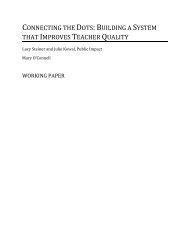Using Competency-Based Evaluation to Drive Teacher Excellence
Using Competency-Based Evaluation to Drive Teacher Excellence
Using Competency-Based Evaluation to Drive Teacher Excellence
Create successful ePaper yourself
Turn your PDF publications into a flip-book with our unique Google optimized e-Paper software.
At the center of Singapore’s new<br />
performance management system are<br />
“competencies,” the underlying characteristics<br />
that distinguish the<br />
best performers from the rest.<br />
MOE uses the term, however, it is referring specifically<br />
<strong>to</strong> the underlying traits and habits — patterns<br />
of thinking, feeling, acting, or speaking — that cause<br />
a person <strong>to</strong> be successful in a specific job or role.22<br />
Because different jobs have different demands, the<br />
competencies that contribute <strong>to</strong> outstanding performance<br />
differ as well. For example, being an outstanding<br />
teacher requires a different set of competencies<br />
than those for an outstanding principal. Validating<br />
the competencies necessary for a particular role, as<br />
well as the levels of increasingly successful behavior<br />
within each competency, is possible if developers are<br />
willing <strong>to</strong> invest in the underlying research.23<br />
The research method Singapore used <strong>to</strong> develop<br />
its competency model was designed in the United<br />
States in the 1970s by Harvard University researcher<br />
David McClelland.24 His approach is fairly simple:<br />
researchers select two groups of current job holders,<br />
one that has displayed average performance according<br />
<strong>to</strong> an agreed-upon set of outcome measures, and<br />
another that has displayed outstanding performance<br />
on the same set of measures. Researchers then use a<br />
structured interview technique called the Behavior<br />
Event Interview (BEI) <strong>to</strong> elicit detailed s<strong>to</strong>ries that<br />
reveal how very high performers differ from more<br />
typical or lower-performing job holders.25<br />
During the BEI, selected job holders are interviewed<br />
for two <strong>to</strong> three hours about details of<br />
what they did, said, thought, and felt as they went<br />
through critical incidents at work. These interviews<br />
are recorded, transcribed, and coded for patterns of<br />
behavior. The patterns displayed by both groups are<br />
recorded as baseline behaviors, while those exhibited<br />
only by the high performers are used <strong>to</strong> develop a<br />
scale of increasingly effective behaviors associated<br />
with that competency.26 For example, the competency<br />
called “initiative” focuses on exhibiting the<br />
drive and actions <strong>to</strong> do more than is expected <strong>to</strong> accomplish<br />
a challenging task. As the scale increases,<br />
so does the complexity of the actions associated with<br />
this competency, from “acting decisively in critical<br />
situations” <strong>to</strong> the more sophisticated “identifying<br />
and preventing potential problems before they<br />
happen.”27<br />
Singapore’s teacher competency model. There<br />
are three major roles in Singaporean schools —<br />
teachers, principals, and school specialists. In order<br />
<strong>to</strong> develop a competency model for each of them,<br />
education ministry officials hired trained researchers<br />
and interviewers from a human resources firm<br />
based in the United States.28 The teacher competency<br />
model the firm developed for Singapore includes<br />
three <strong>to</strong>ols: 1) short, broad definitions of the<br />
competencies that distinguish high performance;<br />
2) rating scales of increasingly more effective levels<br />
of behavior within each competency; and 3) competency<br />
level targets for each job.29 The strength<br />
of the model is its ability <strong>to</strong> correlate a job holder’s<br />
performance on the competency scale <strong>to</strong> successful<br />
attainment of work-related goals.30 Increasing levels<br />
of competence are designed <strong>to</strong> enable teachers <strong>to</strong><br />
perform better in the key result areas identified as<br />
critical <strong>to</strong> effective teaching in Singapore — student<br />
learning and development, contribution <strong>to</strong> the school<br />
community, working with parents, and professional<br />
development.31<br />
Researchers use structured interviews<br />
called Behavior Event Interviews<br />
<strong>to</strong> elicit detailed s<strong>to</strong>ries that reveal how<br />
<strong>to</strong>p performers differ from typical<br />
performers in a job.<br />
8 | lessons from singapore www.opportunityculture.org





